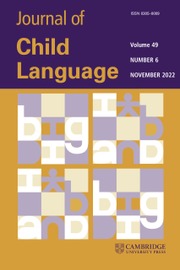Function as a criterion for the extension of new words
Published online by Cambridge University Press: 20 March 2001
Abstract
Four experiments examine the child's ability to draw on functional information to predict the similarity of function across exemplars and to extend new words from an initial exemplar to one of two others. Experiments 1 and 2 tested 16 three- and four-year-olds each (mean ages: 4;5 and 4;4, in Experiments 1 and 2, respectively) and reveal that three- and four-year-olds are able to predict similarity of function and to extend new words on the basis of function if the function is based on shape, but not if the function is based on material makeup. Experiment 3 tested 53 older children, at three age groups (mean ages: 7;2, 8;3, 9;10) and suggests that seven-year-olds have more difficulty in judging similarity of function on the basis of material makeup than eight- and nine-year-olds, and that nine-year-olds are more likely than seven- and eight-year-olds to use functional information to extend new words. Experiment 4 tested 108 children in two age groups (with mean ages of 7;9 and 9;8) and reveals that when function is pitted against syntax as criteria for categorization under a new name, seven-year-olds are more attentive to syntax than nine-year-olds, while nine-year-olds are more attentive to function than seven-year-olds. The cognitive difficulties associated with judgements concerning material function are discussed in relation to additional factors that could lead children under age nine to perform in a non-adult-like fashion in the extension of new names.
Information
- Type
- Research Article
- Information
- Copyright
- © 2001 Cambridge University Press
Footnotes
- 16
- Cited by

